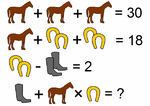T
You are using an out of date browser. It may not display this or other websites correctly.
You should upgrade or use an alternative browser.
You should upgrade or use an alternative browser.
pferdefreund
Citizen of Zooville
Douglas Adams.
B
BlueBeard
Guest
13?
Secret Furry
Tourist
120?
B
BlueBeard
Guest
Oh wait, 1+10 X 2 = 22
pferdefreund
Citizen of Zooville
This is one of these confusing moments in life, where I may look incredibly stupid, incredibly smart, or incredibly smug....
But dude, the above "riddle" is as easy to read as plain numbers. How did you read 48 for the "?" ? Is this a riddle? I am so unsure of things now.
(please don't ban me)
But dude, the above "riddle" is as easy to read as plain numbers. How did you read 48 for the "?" ? Is this a riddle? I am so unsure of things now.
(please don't ban me)
B
BlueBeard
Guest
What? ... I feel so stupid now.This is one of these confusing moments in life, where I may look incredibly stupid, incredibly smart, or incredibly smug....
But dude, the above "riddle" is as easy to read as plain numbers. How did you read 48 for the "?" ? Is this a riddle? I am so unsure of things now.
(please don't ban me)
pferdefreund
Citizen of Zooville
What? ... I feel so stupid now.
Vice versa, I feel detached from reality atm.
Secret Furry
Tourist
I think the horse is 10. The horse shoe is 4. The boots are 2 so I'd be 2 + 10 × 4...... 48 I think I did 12 times 10 in my head lol oops
B
BlueBeard
Guest
A pair of boots is 2. A single boot is 1. Right?
That's how I figured it.
But what if numerals are a distraction? What if it's analagous? That's what's got me hedging.
That's how I figured it.
But what if numerals are a distraction? What if it's analagous? That's what's got me hedging.
pferdefreund
Citizen of Zooville
I think the horse is 10. The horse shoe is 4. The boots are 2 so I'd be 2 + 10 × 4...... 48 I think I did 12 times 10 in my head lol oops
yes, but PEMDAS. I also get ZTHorse now...
pferdefreund
Citizen of Zooville
yes, but PEMDAS.
so it WAS a riddle. I was so on the wrong trajectory where Talio wanted to go.
Secret Furry
Tourist
I haven't had any coffee yet can I blame that on my stupidityyes, but PEMDAS.
pferdefreund
Citizen of Zooville
I haven't had any coffee yet can I blame that on my stupidity
Although Bluebeard would also have an argument, that one boot is one when two boots is 2.
This would be one of these internet-things where both sides can have a right to be "correct" and the designer just wants to eat popcorn. I am just noticing that now, tbh. My eyes initially roled over the symbols to quickly. - The argument for the "mathy" side would however be, that math doesn't work that way. A single boot as a symbol would not be defined by the given equations and thus the set of equations would be unresolvable.
Sneaky designer also pulled the same trick with the pair and then single horse shoe....
Ingo69
Lurker
I think you're right.1+10 X 2 = 22
lol i figured it was
horse = 10 --------- 3 horse = 30 so 30/3=10
Horseshoe = 4 -------- 10(horse) + 4 + 4 = 18
Boots = 2 ----- 4 - 2 = 2
Final equation - 2+(10x4)=42
I didn't put too much thinking into it, I didn't think about PEMDAS. Its not 48, i think its 42 now.
horse = 10 --------- 3 horse = 30 so 30/3=10
Horseshoe = 4 -------- 10(horse) + 4 + 4 = 18
Boots = 2 ----- 4 - 2 = 2
Final equation - 2+(10x4)=42
I didn't put too much thinking into it, I didn't think about PEMDAS. Its not 48, i think its 42 now.
pferdefreund
Citizen of Zooville
same here, I just read-solved it while scrolling over it...
If we accept that math also has a graphical element, as the spirit of the riddle seems to aim for... what if the horses have different numbers of horse-shoes?
If the horse in the second equation lost a shoe, and the boot obviously has zero shoes...
If we accept that math also has a graphical element, as the spirit of the riddle seems to aim for... what if the horses have different numbers of horse-shoes?
If the horse in the second equation lost a shoe, and the boot obviously has zero shoes...
Ingo69
Lurker
Well, no!Final equation - 2+(10x4)=42
Note that there's ony one horseshoe and one boot. So it's each half the value.
aqua
Zooville Philanthropist
41 if you notice it's one boot instead of two, and if you follow order of operations (pemdas). 44 is also sometimes accepted on admission exams, which is ridiculous. Something about 'teaching the controversy' ... lol
EDIT: ballsack! I didn't notice there was only one horseshoe too. 21. Or 22 if you live in bizarro land where order of operations is negotiable.
EDIT: ballsack! I didn't notice there was only one horseshoe too. 21. Or 22 if you live in bizarro land where order of operations is negotiable.
Last edited:
CK4957 STD
Citizen of Zooville
1+(10x2)=21
Ingo69
Lurker
What you say is absolutely logical and true. But I know similar puzzles in which the solution has always been achieved in the way I have shown.XX either equals X x X or a completely different variable. XX = 2X is a separate equation and in this case 100% assumption.
caikgoch
Esteemed Citizen of ZV
Yes, and millions vote straight ticket because it's easier. Does that make it right? Or best?What you say is absolutely logical and true. But I know similar puzzles in which the solution has always been achieved in the way I have shown.
Ingo69
Lurker
I assume that you are a mathematician who takes this topic very seriously.Yes, and millions vote straight ticket because it's easier. Does that make it right? Or best?
Hehe sly memes.Well, no!
Note that there's ony one horseshoe and one boot. So it's each half the value.
T
Tailo
Guest
My votes go to @CK4957 STD for the first to post the correct answer to the task as it was meant in my humble opinion, to @caikgoch for his earlier respectable argument where the riddle is ambiguous and hence can also be interpreted not to have a single number as solution and to @pferdefreund for making me laugh three times and the clever argument that the horses may have horse shoes on them, too. Hard to see at this resolution ... 
pferdefreund
Citizen of Zooville
I assume that you are a mathematician who takes this topic very seriously.
Sometimes it is difficult - i once infuriated a (standardized) tester at school when i refused to do these "what's the next number" questions. My answer was "you can never know. For any number a logical 'law' could be found to explain it."
The resulting row drew in several teachers until a math teacher arrived, realized what was happening and suggested to just give me the tests for the next grade up.


